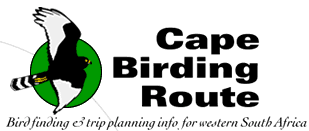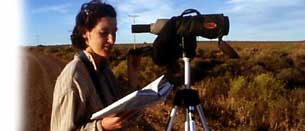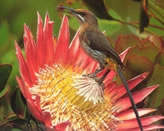|
|
Eierkop
to Katbakkies
As you head north from Eierkop along the R355, the landscape
becomes progressively more arid until, approaching Katbakkies,
bushes are few and far between and the ground gleams with the
mineral patina of the desert pebbles. This is classic Tractrac
Chat country: birds are most often spotted, 10—15 km
north of Eierkop, as they flush near the road, and display their
white rumps as they fly a short distance to perch again on a
fence or low bush.
The
commonest larks of this stretch of road are Thick-billed
and Red-capped. Spike-heeled Lark is also regularly
seen. It is worth keeping an eye out for pairs of superbly
camouflaged Karoo Korhaans, although they have become
scarcer here in recent years. Listen for their frog-like calls
at dawn, and check in the shade of the occasional roadside
tree at midday. Drainage lines with slightly denser scrub
are good areas to search for small, restless flocks of Cape
Penduline Tit, best detected by their soft, inconspicuous
call.
Pale
Chanting Goshawks are reasonably
common throughout the Tanqua Karoo, and Greater Kestrels
frequently wander into the area. If you are lucky enough to
visit after recent rain, you will see that pools forming close
to the road invariably attract South African Shelduck,
drinking flocks of Namaqua Sandgrouse and irruptive
seedeaters such as Lark-like Bunting.
Twenty-one
kilometres from Eierkop, turn left at the road signposted
‘Kagga Kamma; Op-die-berg’, to the small picnic
spot and legendary birding site popularly known as Katbakkies.
Another
worthwhile detour on a return trip from Katbakkies takes in
the less-travelled road linking the R355 to the R356. Five
kilometres north of the turn-off to Katbakkies on the R355,
turn right (east), onto an unnumbered road signposted ‘Sutherland’.
Before turning off here, it is well worth continuing north
along the R355 for about 500 m and birding the patch of acacia
thicket at a lay-by on the left-hand side of the road. Pririt
Batis is almost guaranteed here, along with Cape Penduline
Tit, Yellow-bellied Eremomela, Titbabbler
and sometimes Namaqua Warbler.
The
un-numbered Sutherland road to the R356 offers a chance at
Karoo Korhaan, Greater Kestrel, Double-banded
Courser, Namaqua Sandgrouse and Tractrac Chat.
When you reach the R356, turn right (south) and you will ultimately
join the R355 at 2 on the map on p.76. Fourteen kilometres
south of the junction between the un-numbered road and the
R356, there is a hillock (Fonteinskop) a little way to the
west of the road which is also good for Karoo Eremomela.
(Note, however, that this loop is about twice the distance
of the direct return to Karoopoort on the R355).
|
This website is maintained by Birding Africa.
Please do not use any text, images or content from this site without
permission.
© Birding Africa 1997-2009 info@capebirdingroute.org
4 Crassula Way, Pinelands, 7405, Cape Town, South Africa
|

27/09/09: Dalton
Gibbs reports back from Gough
Island! Read the blog!
26/09/09: New Cape
Town Pelagics trip report from trips of 12 and 19 September
2009.
30/08/09: British
Birdwatching Fair at Rutland Water proved very successful,
with sunny weather and over 20,000 visitors. Callan's "Birding
Namibia and the Okavango" was the most highly-attended
lecture on the Saturday, with over 240 people. Congratulations
to the winners of the Birding Africa competition and the
African Bird Club raffle that we helped sponsor!
12/08/09: New Cape
Town Pelagics trip reports from August and July 2009.
Highlights: Little
Shearwater and more!
07/08/09: The
sub-adult Black Sarrowhawk visits our garden again! Read
on about Raptor Research in the Western Cape.
27/07/09: Cape
Town's Verreauxs' Eagle Chick has grown! And its sibling
never had a chance to hatch. See the pictures of the chick,
its nest and the breeding pair. Find out more about the Western
Cape Raptor Research Programme.
27/07/09: To follow modern nomenclature and systematics, we've
adopted the IOC
World Bird List, Version 2.1.
13/07/09: The 8th
African Bird ID Challenge has launched! Win a 50% discount
on a Cape Town Pelagics
trip, a copy of Southern
African Birdfinder, or African
Bird Club membership for 1 year.
6 July 09: Cape
White-eye research in our garden.
2 July 09: Cape
Town's Verreauxs' Eagle Chick has hatched! See the pictures
of the chick, its nest and the breeding pair. Find out more
about the Western Cape Raptor Research Programme.
2 July 09: Campbell
Fleming, a Cape Town scholar, avid birder and photographer,
joined Birding Africa last month as an intern. Click here,
to see what he got up to.
2 July 09: New pelagic
trip reports from the Cape Town Pelagics trips in June
2009. Highlights: Slenderbilled
Prion and Leach's Storm Petrel
30 july 09: Our latest Cape Fynbos and Karoo trip
reports feature Hottentot
Buttonquail, Cinnamon-breasted
Warbler and other fynbos and Karoo endemics...
26 June 09: Tungsten
mining threatens RAMSAR site, South Africa's Verlorenvlei.
Read the Media Release.
22 June 09: Claire
Spottiswoode, one of the Cape Birding Route founders,
was part of the exploratory team at Mount Mabu. The mountain
is part of the newly discovered largest
rainforest in Southern Africa.
11 June 09: A colour-ringed
Black Sparrowhawk visits the Birding Africa office garden.
Read why it's a 10 months old male!
14 June 09:
Wildlife
at the office of The Cape Birding Route, Birding Africa
and Cape Town Pelagics.
31 May 09:
Michel Watelet wins the 7th African Bird Club & Birding Africa
ID Challenge. Test your African birding skills and WIN
a Birding
Africa Cape town day trip or a copy of the Birdfinder!
30 May 09:
A tragedy unfolds at Kommetjie south of Cape town as 44 beached
False
Killer Whales were shot. Click here for more details and
pictures.
14 March 09: Raptor
Watch in Cape Town on 14 March 09
|
|


